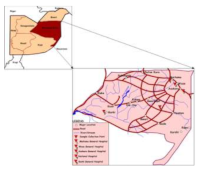RADIOLOGICAL EVALUATION OF LEAD APRON INTEGRITY IN FIVE SELECTED HOSPITALS IN ABUJA, NIGERIA
Main Article Content
Abstract
Background: The general consensus is that any exposure to ionising radiation carries a risk. Diagnostic radiology is the largest (87%) contributor to man-made ionising radiation, therefore any economical and socially acceptable means of reducing dose without compromising the diagnostic value of the procedure must be worth implementing.
Aim: This study is aimed at evaluating lead apron integrity in five selected Hospitals in Abuja, Nigeria.
Methodology: The methodology approach includes the application of a large area beam for transmission measurement with the placement of OSLD before and behind the ten (10) lead aprons to determine the entrance and exit dose as well as the transmission factor. In this study, lead apron consisting of 0.25mm and 0.35mm thickness were examined.
Results: The result shows that the transmittance factor of the entrance and exit dose through the lead equivalent aprons is directly proportional to the age of the apron with NHA1 having the highest transmission factor (0.83) and oldest age (16 years). WGH2 has the lowest transfer factor (0.12) and the least age (1 year).
Conclusion: Lead aprons loses their attenuation capability over time and should be replace after 15 years at most for effective protection against ionizing radiation.
Downloads
Article Details
Section

This work is licensed under a Creative Commons Attribution-NonCommercial 4.0 International License.
All articles in JRRS are published under the Creative Commons Attribution 4.0 International License (CC BY 4.0). This permits unrestricted use, distribution, and reproduction in any medium, provided the original work is properly cited.
How to Cite
References
[1] Bappah SY, Umar I, Samson DY, Mundi AA., Idris MM., Habib S., Anas M., Reuben JS. Performance Evaluation of Thermolumniscence Dosimeters in Personnel in-Vivo Dosimetry. Dutse Journal of Pure and Applied Sciences, (DUJOPAS), 2019; 5 (2a): 195-203.
[2] National Radiological Protection Board. Patient dose reduction in Diagnostic Radiology. HMSO, London, Documents of the NRPB 1990; 1(3): 3-11.
[3] International Commission on Radiological Protection, 1990. Recommendation of the International Commission on Radiological Protection. Oxford: Pergamon Press, 1991: ICRP Publication 60. Ann ICRP; 21(1-3).
[4] Fung KK, Gilboy WB. The effect of beam tube potential variation on gonad dose to patients during chest radiography investigated using high sensitivity LiF: Mg, Cu, P thermoluminescent dose meters. British Journal of Radiology, 2001; 74(880):358e67.
[5] International Commission on Radiological Protection. Report of the task group on reference man. Oxford: Pergamon Press, 1975: ICRP Publication 27
[6] Christodoulou EG, Goodsitt MM, Larson SC, Darner KL, Satti J, Chan HP. Evaluation of the transmitted exposure through lead equivalent aprons used in the radiology department, including the contribution from backscatter. Medical Physics Journal, 2003; 30(6):1033-8.
[7] Simon SL. Organ-specific external dose coefficients and protective apron transmission factors for historical dose reconstruction for medical personnel. Health Physics Journal, 2011; 101(1):13e27.
[8] Lyra M, Charalambatou P, Sotiropoulos M, Diamantopoulos S. Radiation protection of staff in 111in radionuclide therapy is the lead
apron shielding effective? Journal of Radiation Protection and Dosimetry, 1991; 147(1e2):272-6.
[9] McGuire EL, Baker ML, Vandergrift JF. Evaluation of radiation exposures to personnel influoroscopic X-ray facilities. Health Physics Journal,1983; 45(5):975-80
[10] Guo H, Lui WY, He XY, Zhou XS, Zeng Ql, Li BY. Optimizing image quality and radiation dose by the age-dependent setting of tube voltage in pedatric chest digital radiography. Korean Journal of Radiology, 2013; 14(1):126-31.
[11] Johansen S, Hauge IHR, Hogg P, England A, Lanca L, Gunn C, et al. Are antimonybismuth aprons as efficient as lead rubber aprons in
providing shielding again scattered radiation. Journal of Medical Imaging and Radiation Sciences, 2018; 49:201-6.
[12] Hamer OW, Volk M, Zorger N, Borisch I, Buttner R, Feuerbach S, et al. Contrast detail phantom study for X-ray spectrum optimization regarding chest radiography using a cesium iodide-amorphous silicon flat-panel detector. Investigative journal of Radiology, 2004; 39(10):610-8.
[13] Hubbert TE, Vucich JJ, Armstrong MR. Lightweight aprons for protection against scattered radiation during fluoroscopy. American Journal of Roentgenology, 1993; 161:1079-81.
[14] Hayre C, Bungay H, Jeffery C, Cobb C, Atutornu A. Can placing lead-rubber inferolateral to the light beam diaphragm limitionising radiation to multiple radiosensitive organs? Radiography journal, 2017; 24(1):15-21.


